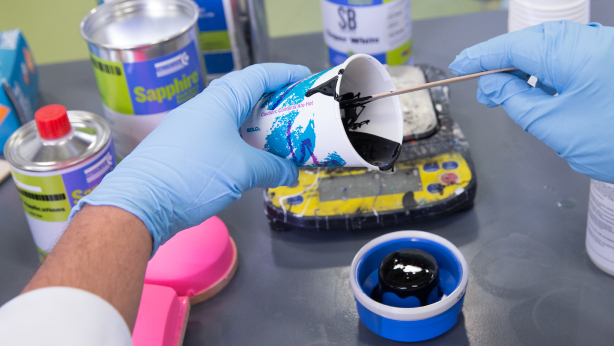- Equipment
- Inks & Supplies
- Services
- Applications
- Tagless
- Resources
- About Us
- Contact Us

First time and seasoned ink mixers alike want to achieve the best results when it comes to printing. Practice, information, and the right pad printing ink viscosity can vastly improve your results. Read on to expand your theoretical knowledge to further your practical skills in the field.
Viscosity is defined as a measure of a liquid’s resistance to flow. To clearly understand this concept, picture pouring honey from a jar versus pouring water from a jar. The viscosity of the honey is much greater than that of water. Attaining the correct viscosity of ink is critical for a smooth printing process. The figure eight test is a great way to check your pad printing ink viscosity, which we will explain later on in the article.

Pad printing is a process which uses an ink cup running back and forth over an etched plate, otherwise known as a cliché to transfer a 2-D image to a pad to then be transferred to a 3-D part.
The ink makeup itself is a huge player when it comes to print quality. There are numerous types of ink available, all to answer specific printing needs. Inkcups carries ten different pad printing specific inks to ensure adhesion on any substrate you can come up with. Our most recent addition to the line, SB Eco Series, is as the name implies, an eco-friendly pad printing which lacks any harmful chemicals from the top brands’ restricted substance list.
Inkcups’ pad printing inks are solvent based made up of three main elements; proprietary binders, resins, and triple milled powered pigments. These pigments are of the highest quality due to their extremely finely milled nature.
Inkcups has prepared an invaluable resource our Sapphire Ink Brochure. Find all lingering questions answered there.
As previously discussed, pad printing inks are solvent based, therefor require a solvent additive to prepare for the printing process. Inkcups offers 11 different solvents to accompany the respective line of pad printing ink. Solvents differ by speed of evaporation rate. During the pad printing process, the ink becomes tacky due to the solvent evaporating from the ink mixture. The tacky nature of the ink is vital to the transfer from silicone pad to substrate.
We have now established that the solvent evaporates as the process progresses. This leaves us working with the ink and the hardener. As the name implies, hardeners main function is to create a hard, abrasion resistant surface for long lasting designs. While the solvent evaporates the hardener hardens the ink that is remaining on the substrate. Just like solvents, hardeners are also specific to the ink series being used.
The ratio of how much hardener to use depends on the application and the series of ink. These factors determine whether one can expect to not use hardener at all, or up to 25% of the weight of ink.
It should be noted that depending on the line of ink the percentage of hardener and solvent added can vary. The following How-To is based off of the SB Series Garment printer ink.
Tip: For best results when mixing ink we suggest you use a paper cup. Due to the nature of solvent, it will dissolve plastic or Styrofoam cups releasing contaminants into your ink.
Inkcups has a video for step-by-step ink mixing as well. Watch it here
Our in-house ink specialist Joe notes that the biggest thing when it comes to inks is repeatability. He advises that every mixture should be weighted on a gram scale to insure the same viscosity time after time.
Living in New England we experience four very distinct seasons. All our customers around the world can relate when it comes to unpredictable weather and changing humidity levels… so how can we have the best environment to pad print in? We suggest keeping your shop climate controlled, between 65 and 75 degrees Fahrenheit.
One of the biggest challenges printers face is when a printing facility gets hot inside. The hotter it is, the quicker the ink wants to dry, expediting the evaporation rate set by the solvent. Equipping your print shop with the ability to control the environment will make for an easier and more enjoyable time printing.
With any new endeavor, it can be overwhelming to get started! We get it. Call us today to talk to an expert technician to set you up with the right ink, solvent, and hardener for your substrate.
Another way to get started is by identifying what you are looking to print on, then mailing it to us. From there, our technicians can identify the material, suggest the best fit ink series and solvent, suggest a hardener if required, and preform an adhesion test in our lab to ensure the best possible adhesion and abrasion resistance available. We also offer color matching by our professional ink mixologists.
Inkcups is here for you every step of the way. Find out more about the services we offer here, Application Consulting.
Back to Blog Home
Add Your Comment